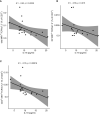Differential Skewing of Circulating MR1-Restricted and γδ T Cells in Human Psoriasis Vulgaris
- PMID: 33343564
- PMCID: PMC7744298
- DOI: 10.3389/fimmu.2020.572924
Differential Skewing of Circulating MR1-Restricted and γδ T Cells in Human Psoriasis Vulgaris
Abstract
Psoriasis vulgaris (PV) is a chronic, recurrent inflammatory dermatosis mediated by aberrantly activated immune cells. The role of the innate-like T cells, particularly gammadelta T (γδT) cells and MR1-restricted T lymphocytes, is incompletely explored, mainly through animal models, or by use of surrogate lineage markers, respectively. Here, we used case-control settings, multiparameter flow cytometry, 5-OP-RU-loaded MR1-tetramers, Luminex technology and targeted qRT-PCR to dissect the cellular and transcriptional landscape of γδ and MR1-restricted blood T cells in untreated PV cases (n=21, 22 matched controls). High interpersonal differences in cell composition were observed, fueling transcriptional variability at healthy baseline. A minor subset of canonical CD4+CD8+MR1-tet+TCRVα7.2+ and CD4+CD8-MR1-tet+TCRVα7.2+ T cells was the most significantly underrepresented community in male PV individuals, whereas Vδ2+ γδ T cells expressing high levels of TCR and Vδ1-δ2- γδ T cells expressing intermediate levels of TCR were selectively enriched in affected males, partly reflecting disease severity. Our findings highlight a formerly unappreciated skewing of human circulating MAIT and γδ cytomes during PV, and reveal their compositional changes in relation to sex, CMV exposure, serum cytokine content, BMI, and inflammatory burden. Complementing numerical alterations, we finally show that flow-sorted, MAIT and γδ populations exhibit divergent transcriptional changes in mild type I psoriasis, consisting of differential bulk expression for signatures of cytotoxicity/type-1 immunity (EOMES, RUNX3, IL18R), type-3 immunity (RORC, CCR6), and T cell innateness (ZBTB16).
Keywords: MR1; cytokines; gammadelta T lymphocytes; mucosal associated invariant T cells; psoriasis.
Copyright © 2020 Plužarić, Štefanić, Mihalj, Tolušić Levak, Muršić, Glavaš-Obrovac, Petrek, Balogh and Tokić.
Conflict of interest statement
The authors declare that the research was conducted in the absence of any commercial or financial relationships that could be construed as a potential conflict of interest.
Figures






Similar articles
-
Characterization of the TCRβ repertoire of peripheral MR1-restricted MAIT cells in psoriasis vulgaris patients.Sci Rep. 2023 Nov 28;13(1):20990. doi: 10.1038/s41598-023-48321-z. Sci Rep. 2023. PMID: 38017021 Free PMC article.
-
Recognition of the antigen-presenting molecule MR1 by a Vδ3+ γδ T cell receptor.Proc Natl Acad Sci U S A. 2021 Dec 7;118(49):e2110288118. doi: 10.1073/pnas.2110288118. Proc Natl Acad Sci U S A. 2021. PMID: 34845016 Free PMC article.
-
Human liver CD8+ MAIT cells exert TCR/MR1-independent innate-like cytotoxicity in response to IL-15.J Hepatol. 2020 Sep;73(3):640-650. doi: 10.1016/j.jhep.2020.03.033. Epub 2020 Apr 2. J Hepatol. 2020. PMID: 32247824
-
MR1-Restricted T Cells Are Unprecedented Cancer Fighters.Front Immunol. 2020 Apr 28;11:751. doi: 10.3389/fimmu.2020.00751. eCollection 2020. Front Immunol. 2020. PMID: 32411144 Free PMC article. Review.
-
MHC class I-related molecule, MR1, and mucosal-associated invariant T cells.Immunol Rev. 2016 Jul;272(1):120-38. doi: 10.1111/imr.12423. Immunol Rev. 2016. PMID: 27319347 Review.
Cited by
-
The miR-20a/miR-92b Profile Is Associated with Circulating γδ T-Cell Perturbations in Mild Psoriasis.Int J Mol Sci. 2023 Feb 21;24(5):4323. doi: 10.3390/ijms24054323. Int J Mol Sci. 2023. PMID: 36901753 Free PMC article.
-
Current Concepts of Psoriasis Immunopathogenesis.Int J Mol Sci. 2021 Oct 26;22(21):11574. doi: 10.3390/ijms222111574. Int J Mol Sci. 2021. PMID: 34769005 Free PMC article. Review.
-
Skin Barrier Dysregulation in Psoriasis.Int J Mol Sci. 2021 Oct 7;22(19):10841. doi: 10.3390/ijms221910841. Int J Mol Sci. 2021. PMID: 34639182 Free PMC article. Review.
-
Characterization of the TCRβ repertoire of peripheral MR1-restricted MAIT cells in psoriasis vulgaris patients.Sci Rep. 2023 Nov 28;13(1):20990. doi: 10.1038/s41598-023-48321-z. Sci Rep. 2023. PMID: 38017021 Free PMC article.
-
RNA m6A demethylase ALKBH5 regulates the development of γδ T cells.Proc Natl Acad Sci U S A. 2022 Aug 16;119(33):e2203318119. doi: 10.1073/pnas.2203318119. Epub 2022 Aug 8. Proc Natl Acad Sci U S A. 2022. PMID: 35939687 Free PMC article.
References
Publication types
MeSH terms
Substances
LinkOut - more resources
Full Text Sources
Medical
Research Materials
Miscellaneous

